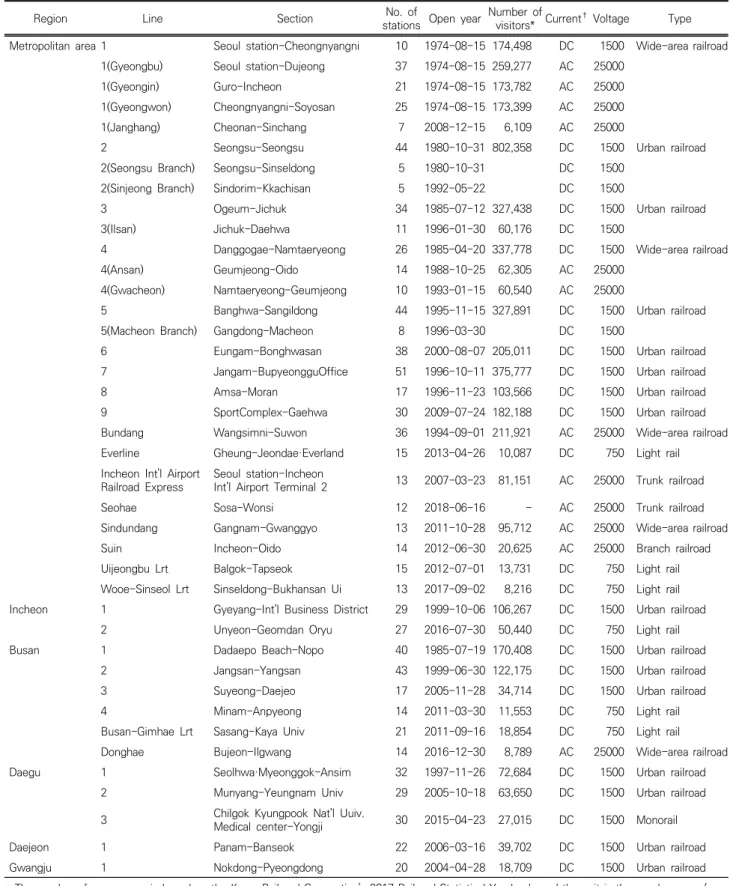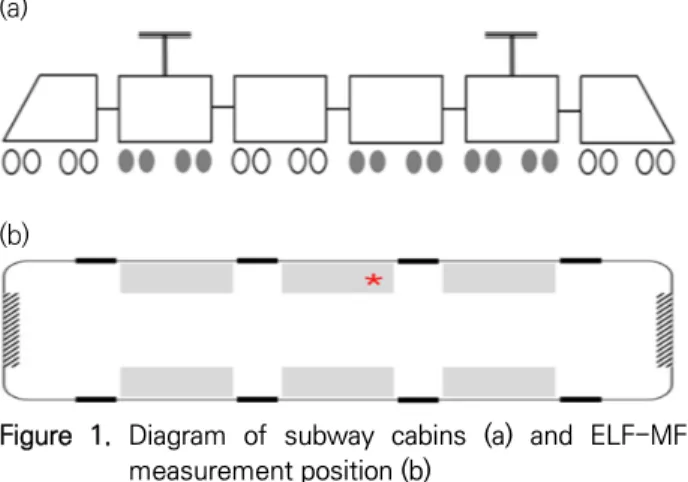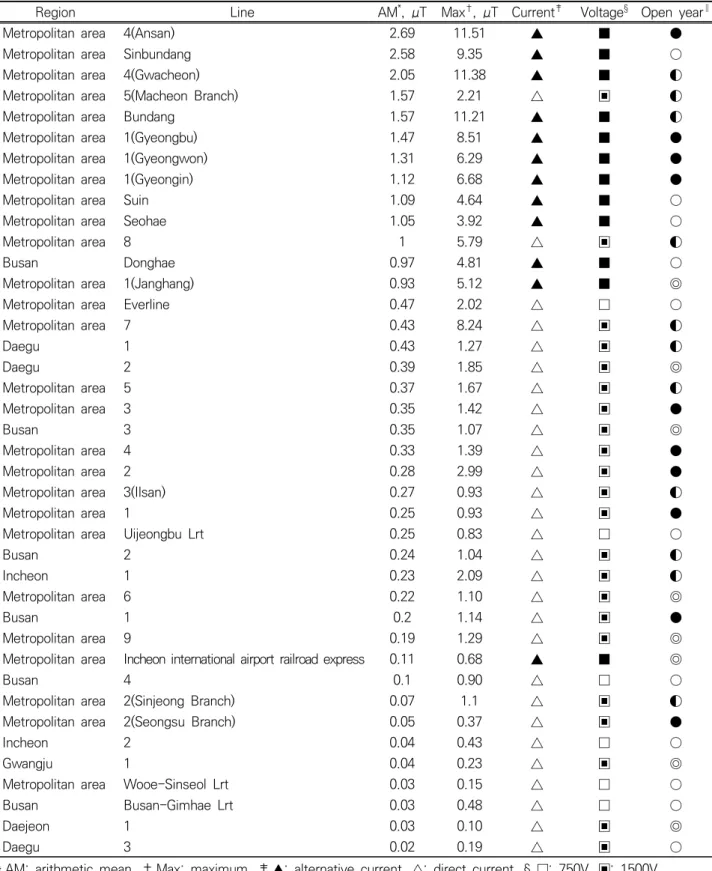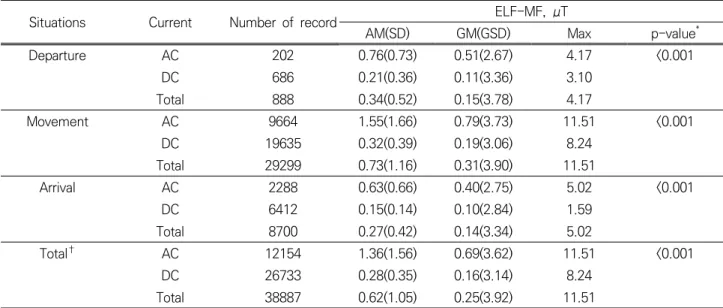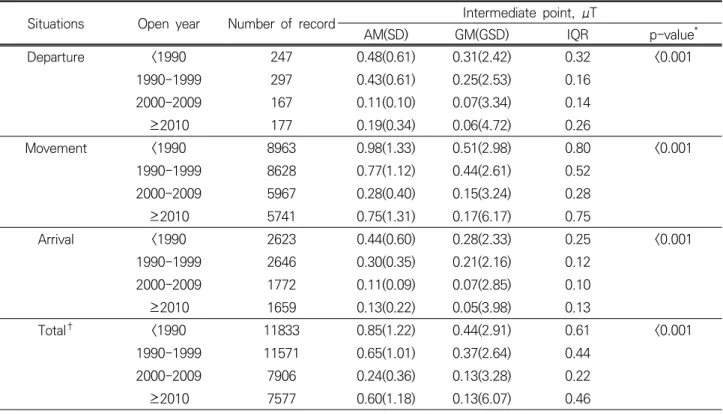I. 서 론
1979년 전력선 주변에 거주하는 아동들과 소아백혈병 사이의 연관성 연구(Wertheimer & Leeper, 1979)를
시작으로 극저주파 자기장(extremely low frequency magnetic field, ELF-MF)과 인체의 건강에 대한 역학 연구 사례가 보고되고 있다. Floderus et al.(1994)은 철도 산업에 종사하는 근로자들을 대상으로 환자-대조
지하철 운행 중 발생하는 객차 내부 극저주파 자기장(ELF-MF) 세기 평가
이지현1,3ㆍ강명지2ㆍ박윤경3ㆍ박동욱4ㆍ최상준3*
1순천향대학교 부속 구미병원 작업환경측정, 2계명대학교 공중보건학과,
3대구가톨릭대학교 산업보건학과, 4한국방송통신대학교 환경보건학과
Evaluation of Intensity of Extremely Low Frequency Magnetic Fields (ELF-MF) Inside of Cabins as Generated During Subway Operation
Jihyun Lee1,3ㆍMyeongji Kang2ㆍYunkyung Park3ㆍDonguk Park4ㆍSangjun Choi3*
1Work Environment Measurement, Gumi Hospital, SoonChunHyang University
2Department of Public Health, KeiMyung University
3Department of Occupational Health, Daegu Catholic University
4Department of Environment Health, Korea National Open University
ABSTRACT
Objective: This study was conducted to investigate the intensity of the extremely low frequency magnetic fields(ELF-MF) generated inside of the cabins during subway operation.
Methods: The ELF-MF intensity were investigated on 30 subway lines in Korea, including in the Greater Seoul Metropolitan Area(Seoul and Gyeonggi-do Province), Incheon, Busan, Daegu, Daejeon, and Gwangju. ELF-MF intensity was measured at 0.9 m from the floor using EMDEX II meters with a resolution of 0.01 μT. All data were collected every three seconds and analyzed with EMCALC 2013 version 3.0B software. Basic characteristics of subway operation, including alternative current(AC) or direct current(DC), voltage level, and opening year of the line were investigated. Real-time information during measurement, such as the time of departure, moving and arrival of trains, were also recorded.
Results: The arithmetic mean(AM) and maximum(Max) intensity of ELF-MF were 0.62 μT and 11.51 μT, respectively. Compared by region, the ELF-MF intensity measured inside cabin were the highest in the Seoul Metropolitan Area(AM=0.80 μT), followed by Busan(AM=0.30 μT), Daegu(AM=0.29 μT), Incheon(AM=0.14 μT), Gwangju(AM=0.04 μT) and Daejeon(AM=0.03 μT). The average ELF-MF level measured in AC trains(AM=1.36 μT) was also significantly higher than in DC trains(AM=0.28 μT). In terms of the opening year of the subway, trains opened before 1990(AM=0.85 μT) was the highest and the lowest was 2000-2009(AM=0.24 μT).
Conclusions: The AC supply has the greatest influence on the generation of the ELF-MF intensity in subway cabins.
Key words: alternative current, ELF-MF, subway
*Corresponding author: Sangjun Choi, Tel: 053-850-3738, E-mail: junilane@gmail.com
Department of Occupational Health, Daegu Catholic University, 13-13, Hayang-ro, Gyeongsan-si, Gyeongbuk, 38430 Received: February 21, 2019, Revised: May 22, 2019, Accepted: May 28, 2019
Jihyun Lee https://orcid.org/0000-0002-3419-3854 Myeongji Kang https://orcid.org/0000-0003-2948-2835 Yunkyung Park https://orcid.org/0000-0002-4068-3745 Donguk Park https://orcid.org/0000-0003-3847-7392 Sangjun Choi https://orcid.org/0000-0001-8787-7216
This is an Open-Access article distributed under the terms of the Creative Commons Attribution Non-Commercial License (http://creativecommons.org/licenses/by-nc/3.0) which permits unrestricted non-commercial use, distribution, and reproduction in any
군 연구를 수행한 결과 뇌하수체의 암, 유방암, 그리고 젊은 연령층에서의 뇌암이 일반인구에 비해 현저히 높 게 나타났으며 이는 철도 근무에서의 높은 전자파 노출 때문일 것으로 추정하였다. Minder & Pfluger(2001) 는 극저주파 자기장에 대한 노출이 백혈병과 뇌종양 사 이에 약한 연관성이 있다고 결론지었다. 또한 전자파 노 출로 인해 갑자스런 심근경색의 위험이 증가하며 (Santangelo et al., 2005), 전자파에 대한 장기 노출 은 급성 심근경색 및 부정맥 사망과 관련이 있다는 보 고도 있다. 이 외에도 전자파 노출이 여성에게 유방암 발생 및 위험을 증가시킨다는 역학 연구 사례도 보고되 었다(Loomis et al., 1994; Labreche et al., 2003).
반면 극저주파 자기장 노출이 인체에 영향을 미치지 않 는다는 연구도 있다. 전자파 노출과 남성 유방암 발생의 관계를 평가한 Pollán et al.(2001)의 연구에 의하면 전자파 노출수준이 다른 직업별로 유의한 차이가 발견 되지 않았다고 한다. 50Hz 자기장의 직업적 노출과 여 성 유방암의 발생을 연구한 일부 문헌에서도 그 위험도 가 다소 낮다고 보고되고 있다(Kliukiene et al., 2004). 전기 관련 근로자의 자기장 노출은 동맥경화증, 만성 심장동맥성 심질환과는 연관성이 없었다고 하였다 (Savitz et al., 1999). 또한 Navas-Acién et al.
(2002) 연구에서는 극저주파 자기장 노출과 수막종 위험 사이에 연관성을 발견하지 못했다고 보고하였다. 이러한 선행 연구를 고려하여 국제 암 연구소(International Agency for Research on Cancer, IARC)는 소아 백 혈병에 대한 제한된 증거를 토대로 극저주파 자기장을 Group 2B(possibly carcinogenic) ‘인간에게 발암 가 능성이 있음’으로 분류하였다.
극저주파 자기장에 대한 노출기준은 전파법 제47조 의2 전자파 인체보호기준에 명시되어 있다(MOLEG, 2017). 60 Hz의 범위에서 일반인에 대한 전자파 인체 보호기준은 5/f(if f=0.06 kH, 83.3 μT)로 설정되어 있다. 국제 기준으로 국제 비이온화 방사 보호 위원회 (International Commission of Non-Ionizing Radiation Protection, ICNIRP, 2018)는 일반 대중 의 경우 200 μT, 미국 정부 산업위생 전문가 협의회 (American Conference of Governmental Industrial Hygienists, ACGIH)의 TLV에서는 60/f mT(if f=60 Hz, 1000 μT)로 설정되어 있다.
극저주파 자기장에 대한 직업적 노출은 사무직이나 주부 혹은 학생들의 노출수준에 비해 약 5배에서 10배
에 이른다고 보고되고 있다(Deadman, 1996; Kim et al., 1997). 구체적으로는 열차 기관사, 선로 보수원, 재 봉사, 벌목업자, 용접공은 2.0 μT 이상의 높은 자기장 에 노출되었다고 보고하였다(Portier & Wolfe, 1998).
지하철은 전기를 이용해 운행되며, 우리나라에서 가장 많은 승객을 빠르게 이동시킬 수 있는 도시의 주요 대중 교통 수단이다. 2017년 한 해 동안 지하철 이용객은 하 루 평균 약 천만 명 정도라고 하며, 일주일에 평균 5–10 회 이용하는 것으로 보고하고 있다(KORAIL, 2017). 최 근 고압전류를 만지는 전기원에 대한 백혈병이 직업병으 로 처음 인정되면서 전자기파에 대한 사회적인 관심은 높아졌다. 하지만 많은 사람들이 이동수단으로 지하철을 이용하고 있으며, 지하철에서 발생되는 전자기파 관련 연구 자료는 부족한 실정이다.
따라서 본 연구에서는 지하철 운행 중 발생하는 극저 주파 자기장의 세기와 극저주파 자기장의 세기에 영향 을 미치는 관련 요인에 대해 알아보고자 한다.
Ⅱ. 대상 및 방법
1. 연구 대상
지하철은 용어상 지하 구간을 이동하는 전철만을 의 미할 수 있으나, 국내에서는 지하뿐만 아니라 지상 구간 도 포함하고 있고, 고가로 이동하는 모노레일도 함께 지 칭하고 있기 때문에 본 논문에서 지하철은 도시 및 주 변 지역을 대상으로 전기 동력을 이용하는 대중교통 수 단의 의미로 정의하였다.
지하철에 사용되는 전류, 전압과 지하철의 개통년도 등에 대한 기초 자료는 각 지하철을 관리하는 운영회사 홈페이지(서울교통공사, 서울시메트로9호선㈜, 한국철 도공사, 의정부 경전철㈜, 우이신설 경전철㈜, 용인 경 량전철㈜, 공항철도㈜, 신분당선㈜ 네오트랜스, 경기철 도㈜, 인천교통공사, 부산교통공사, 부산-김해 경전철㈜, 대구도시철도공사, 대전광역시 도시철도공사, 광주광역 시 도시철도공사)와 철도산업정보센터를 통해 수집하였 다(Table 1).
우리나라 각 지역에서 운행되고 있는 지하철을 대상 으로 2018년 8월 4일부터 2018년 8월 25일까지 극저 주파 자기장의 세기를 측정하였다. 서울과 경기도를 합 쳐 수도권 지역으로 구분하였으며, 수도권 지역은 21개 호선 중 17개 호선으로 서울 1호선∼9호선, 분당선, 용 인 경전철, 공항철도, 서해선, 신분당선, 수인선, 의정부
Region Line Section No. of
stations Open year Number of
visitors* Current†Voltage Type Metropolitan area 1 Seoul station-Cheongnyangni 10 1974-08-15 174,498 DC 1500 Wide-area railroad
1(Gyeongbu) Seoul station-Dujeong 37 1974-08-15 259,277 AC 25000
1(Gyeongin) Guro-Incheon 21 1974-08-15 173,782 AC 25000
1(Gyeongwon) Cheongnyangni-Soyosan 25 1974-08-15 173,399 AC 25000
1(Janghang) Cheonan-Sinchang 7 2008-12-15 6,109 AC 25000
2 Seongsu-Seongsu 44 1980-10-31 802,358 DC 1500 Urban railroad
2(Seongsu Branch) Seongsu-Sinseldong 5 1980-10-31 DC 1500
2(Sinjeong Branch) Sindorim-Kkachisan 5 1992-05-22 DC 1500
3 Ogeum-Jichuk 34 1985-07-12 327,438 DC 1500 Urban railroad
3(Ilsan) Jichuk-Daehwa 11 1996-01-30 60,176 DC 1500
4 Danggogae-Namtaeryeong 26 1985-04-20 337,778 DC 1500 Wide-area railroad
4(Ansan) Geumjeong-Oido 14 1988-10-25 62,305 AC 25000
4(Gwacheon) Namtaeryeong-Geumjeong 10 1993-01-15 60,540 AC 25000
5 Banghwa-Sangildong 44 1995-11-15 327,891 DC 1500 Urban railroad
5(Macheon Branch) Gangdong-Macheon 8 1996-03-30 DC 1500
6 Eungam-Bonghwasan 38 2000-08-07 205,011 DC 1500 Urban railroad
7 Jangam-BupyeongguOffice 51 1996-10-11 375,777 DC 1500 Urban railroad
8 Amsa-Moran 17 1996-11-23 103,566 DC 1500 Urban railroad
9 SportComplex-Gaehwa 30 2009-07-24 182,188 DC 1500 Urban railroad
Bundang Wangsimni-Suwon 36 1994-09-01 211,921 AC 25000 Wide-area railroad Everline Gheung-Jeondae·Everland 15 2013-04-26 10,087 DC 750 Light rail Incheon Int'l Airport
Railroad Express Seoul station-Incheon
Int’l Airport Terminal 2 13 2007-03-23 81,151 AC 25000 Trunk railroad
Seohae Sosa-Wonsi 12 2018-06-16 - AC 25000 Trunk railroad
Sindundang Gangnam-Gwanggyo 13 2011-10-28 95,712 AC 25000 Wide-area railroad
Suin Incheon-Oido 14 2012-06-30 20,625 AC 25000 Branch railroad
Uijeongbu Lrt Balgok-Tapseok 15 2012-07-01 13,731 DC 750 Light rail Wooe-Sinseol Lrt Sinseldong-Bukhansan Ui 13 2017-09-02 8,216 DC 750 Light rail Incheon 1 Gyeyang-Int’l Business District 29 1999-10-06 106,267 DC 1500 Urban railroad
2 Unyeon-Geomdan Oryu 27 2016-07-30 50,440 DC 750 Light rail
Busan 1 Dadaepo Beach-Nopo 40 1985-07-19 170,408 DC 1500 Urban railroad
2 Jangsan-Yangsan 43 1999-06-30 122,175 DC 1500 Urban railroad
3 Suyeong-Daejeo 17 2005-11-28 34,714 DC 1500 Urban railroad
4 Minam-Anpyeong 14 2011-03-30 11,553 DC 750 Light rail
Busan-Gimhae Lrt Sasang-Kaya Univ 21 2011-09-16 18,854 DC 750 Light rail
Donghae Bujeon-Ilgwang 14 2016-12-30 8,789 AC 25000 Wide-area railroad
Daegu 1 Seolhwa·Myeonggok-Ansim 32 1997-11-26 72,684 DC 1500 Urban railroad
2 Munyang-Yeungnam Univ 29 2005-10-18 63,650 DC 1500 Urban railroad
3 Chilgok Kyungpook Nat’l Uuiv.
Medical center-Yongji 30 2015-04-23 27,015 DC 1500 Monorail
Daejeon 1 Panam-Banseok 22 2006-03-16 39,702 DC 1500 Urban railroad
Gwangju 1 Nokdong-Pyeongdong 20 2004-04-28 18,709 DC 1500 Urban railroad
⁕ The number of passengers is based on the Korea Railroad Corporation's 2017 Railroad Statistical Yearbook, and the unit is thousand persons/year.
† AC; alternative current, DC; direct current
Table 1. The basic characteristics of the subway investigated in this study
경전철, 우이신설 경전철을 대상으로 하였다. 수도권 이 외의 지역은 모두 광역시에서 운영되는 지하철을 대상 으로 하였다. 인천광역시는 인천 1호선과 2호선으로 2 개 호선, 부산광역시는 부산 1호선∼4호선, 부산-김해 경전철, 동해선으로 6개 호선, 대구광역시는 대구 1호 선∼3호선으로 3개 호선, 대전광역시와 광주광역시는 각각 1개 호선을 대상으로 측정하였다.
2. 측정 방법
극저주파 자기장 측정은 EMDEX II(Enertech Consultants Inc. Patterson, CA, USA)를 사용하였다. EMDEX II는 자체 센서를 통해 자기장의 세 직교 벡터 성분(X, Y, Z축)을 측정할 수 있도록 개발된 측정기이다. 이 측정기는 실시간 으로 자료를 기록하며, 측정 가능 범위는 0.01∼300 μT, 주파수 대역은 광대역(broadband) 40∼800 Hz, 분해능 (resolution) 0.01 μT로 모니터링 할 수 있다. 자기장의 측정 단위로 Tesla(T) 또는 Gauss(G)가 있으나, 국제단위 계에서 자기장의 단위는 Tesla(T)를 사용하고 있다. 따라 서 본 연구에서는 극저주파 자기장 단위로 micro Tesla(μ T)를 사용하였다. 전국 지하철을 대상으로 극저주파 자기 장 세기의 측정을 실시하기 전 ANSI/IEEE 교정 절차에 따라 정기적으로 교정하였다.
전국 지하철 호선에 대한 측정은 각 호선의 전체 구 간 중 첫 번째 역에서부터 시작하였다. 호선별로 자기장 측정을 실시한 차량은 변전소에서 공급된 전력을 받는 열차로써 열차 하부에 모터(motor)가 연결되었거나, 팬 터그래프(pantograph)가 연결된 것으로 선정하였다 (Figure 1-a). 측정 위치는 Figure 1-b와 같이 차량 내부에 배치된 좌석 중 중앙 좌석의 한 지점으로 좌석 에 앉았을 때 머리 위치(바닥으로부터 0.9 m)에서 3초 (a)
(b)
Figure 1. Diagram of subway cabins (a) and ELF-MF measurement position (b)
간격으로 측정하였다. 극저주파 자기장이 역사별, 열차 가 이동 및 정차할 때 발생하는 차이를 확인하고자 극 저주파 자기장 측정을 실시하는 동안 각 역 구간마다 출발, 이동, 도착하는 시간을 기록하였다.
3. 자료 처리 및 통계 분석
EMCALC 2013(Enertech Consultants Inc. Patterson, CA, USA)을 이용해 EMDEX II에서 측정된 데이터를 처리하였다. 극저주파 자기장의 데이터는 Kolmogorov- Smirnov test를 이용하여 정규성 검정을 하였으나, 유의 확률이 0.001 미만으로 정규분포(normal distribution) 를 따르지 않았다. 따라서 다운받은 데이터들은 대수 변 환을 하였으며 산술평균(arithmetic mean, AM), 표준 편차(standard deviation, SD), 기하평균(geometric mean, GM), 기하표준편차(geometric standard deviation, GSD), 사분위 범위(interquartile range, IQR), 범위 (range)로 요약하였다. 전체 데이터 결과 값 중 우이신 설 경전철(17.3%), 인천 2호선(2.7%), 공항철도(0.5%), 대구 3호선(3%), 광주(13.6%)의 일부 구간은 제로(0)로 나타나서 측정기의 검출한계 값인 0.01 μT의 1/2 값으 로 적용하여 자료 분석을 하였다(Hornung & Reed, 1990; Hewett, 2006).
측정 위치로부터 객차 운행상태, 공급전기 형태, 개통 년도에 따른 극저주파 자기장 세기의 비교는 일원분류 분산분석(one-way ANOVA), 이원분류 분산분석 (two-way ANOVA)를 사용하여 분석하였다. 극저주파 자기장에 영향을 주는 요인을 알아보기 위해 다중회귀 분석(multiple regression analysis)의 후진제거법 (backward elimination)을 이용하였으며, 모든 데이터 분석은 Microsoft Excel 2016(Microsoft corporation, Redmond, WA. USA)과 PASW statistics 20(IBS SPSS, USA) 프로그램을 이용하였다.
Ⅲ. 결 과
Table 2은 극저주파 자기장 세기가 높은 호선들에 대해 순서를 매겼으며, 극저주파 자기장 세기에 영향이 높은 요인들이 무엇인지 쉽게 볼 수 있도록 요약하여 표로 제시하였다. 사용되는 전류가 교류이고, 전압은 25,000 V, 2000년 이전에 개통된 지하철에서 극저주 파 자기장이 높게 발생된다는 것을 알 수 있었다.
Region Line AM*, μT Max†, μT Current‡ Voltage§ Open year∥
Metropolitan area 4(Ansan) 2.69 11.51 ▲ ■ ●
Metropolitan area Sinbundang 2.58 9.35 ▲ ■ ○
Metropolitan area 4(Gwacheon) 2.05 11.38 ▲ ■ ◐
Metropolitan area 5(Macheon Branch) 1.57 2.21 △ ▣ ◐
Metropolitan area Bundang 1.57 11.21 ▲ ■ ◐
Metropolitan area 1(Gyeongbu) 1.47 8.51 ▲ ■ ●
Metropolitan area 1(Gyeongwon) 1.31 6.29 ▲ ■ ●
Metropolitan area 1(Gyeongin) 1.12 6.68 ▲ ■ ●
Metropolitan area Suin 1.09 4.64 ▲ ■ ○
Metropolitan area Seohae 1.05 3.92 ▲ ■ ○
Metropolitan area 8 1 5.79 △ ▣ ◐
Busan Donghae 0.97 4.81 ▲ ■ ○
Metropolitan area 1(Janghang) 0.93 5.12 ▲ ■ ◎
Metropolitan area Everline 0.47 2.02 △ □ ○
Metropolitan area 7 0.43 8.24 △ ▣ ◐
Daegu 1 0.43 1.27 △ ▣ ◐
Daegu 2 0.39 1.85 △ ▣ ◎
Metropolitan area 5 0.37 1.67 △ ▣ ◐
Metropolitan area 3 0.35 1.42 △ ▣ ●
Busan 3 0.35 1.07 △ ▣ ◎
Metropolitan area 4 0.33 1.39 △ ▣ ●
Metropolitan area 2 0.28 2.99 △ ▣ ●
Metropolitan area 3(Ilsan) 0.27 0.93 △ ▣ ◐
Metropolitan area 1 0.25 0.93 △ ▣ ●
Metropolitan area Uijeongbu Lrt 0.25 0.83 △ □ ○
Busan 2 0.24 1.04 △ ▣ ◐
Incheon 1 0.23 2.09 △ ▣ ◐
Metropolitan area 6 0.22 1.10 △ ▣ ◎
Busan 1 0.2 1.14 △ ▣ ●
Metropolitan area 9 0.19 1.29 △ ▣ ◎
Metropolitan area Incheon international airport railroad express 0.11 0.68 ▲ ■ ◎
Busan 4 0.1 0.90 △ □ ○
Metropolitan area 2(Sinjeong Branch) 0.07 1.1 △ ▣ ◐
Metropolitan area 2(Seongsu Branch) 0.05 0.37 △ ▣ ●
Incheon 2 0.04 0.43 △ □ ○
Gwangju 1 0.04 0.23 △ ▣ ◎
Metropolitan area Wooe-Sinseol Lrt 0.03 0.15 △ □ ○
Busan Busan-Gimhae Lrt 0.03 0.48 △ □ ○
Daejeon 1 0.03 0.10 △ ▣ ◎
Daegu 3 0.02 0.19 △ ▣ ○
⁕ AM; arithmetic mean, † Max; maximum, ‡ ▲; alternative current, △; direct current, § □; 750V, ▣; 1500V,
■; 25000V, ∥ ●; <1990, ◐; 1990-1999, ◎; 2000-2009, ○; ≥2010
Table 2. Comparison of extremely low frequency magnetic field intensity measured in subway cabins by region, line number, current type, voltage level and open year
1. 지하철 운행 지역에 따른 극저주파 자기장 세기 분포 지하철이 운행되는 수도권(서울, 경기도), 인천, 부산, 대구, 대전, 광주로 그룹을 나눠 극저주파 자기장 세기 를 비교하였다. 6개 지역의 지하철 객차에서 측정한 평 균 극저주파 자기장 세기는 Fig. 2와 같이 수도권 지역 이 0.80 μT로 가장 높았고, 부산 0.30 μT, 대구 0.29 μT, 인천 0.14 μT, 광주 0.04 μT, 대전 0.03 μT로 나 타났으며, 지역별 유의한 차이를 보였다(p<0.001).
Figure 2. The distribution of ELF-MF intensity by region
2. 지하철 운행 상태에 따른 극저주파 자기장 세기 비교 30개 호선을 대상으로 측정 위치에 따른 극저주파 자기장 세기를 열차의 운행상태(출발, 이동, 도착)로 구 분하여 Table 3에 나타내었다. 기록된 총 데이터의 3/4에 해당하는 이동의 평균 극저주파 자기장 세기는 0.73 μT로 가장 높았다. 두 번째로 데이터가 많은 도착 의 경우 0.27 μT였다. 출발의 경우 기록된 데이터 수가 가장 적었지만 평균 극저주파 자기장 세기는 도착보다 높았다(0.34 μT). 열차의 운행상태에 따른 극저주파 자 기장 세기는 이동하는 동안에 발생한 세기가 출발, 도착 에 비해 유의하게 높았다(p<0.001).
3. 공급전기 형태에 따른 극저주파 자기장 세기 비교 지하철에서 사용되는 전류 형식은 교류(alternative current, AC)와 직류(direct current, DC)가 있으며 전 류에 따라서 직류에는 750 V(9.9%)와 1,500 V (58.9%) 전압의 전기가 공급되고 교류에는 25,000 V (31.2%) 전 압의 전기가 공급된다. Table 3는 지하철에 공급되는 전 기 형태에 따른 열차 운행상태별 극저주파 자기장 세기를 나타내었다. 교류가 공급되는 지하철(교류 지하철)에서 측 정된 자기장의 강도(AM=1.36 μT, Max=11.51 μT)는 직 류가 공급되는 지하철(직류 지하철)에서 측정된 것 (AM=0.28 μT, Max=8.24 μT)에 비해 통계적으로 유의
Situations Current Number of record ELF-MF, μT
AM(SD) GM(GSD) Max p-value*
Departure AC 202 0.76(0.73) 0.51(2.67) 4.17 <0.001
DC 686 0.21(0.36) 0.11(3.36) 3.10
Total 888 0.34(0.52) 0.15(3.78) 4.17
Movement AC 9664 1.55(1.66) 0.79(3.73) 11.51 <0.001
DC 19635 0.32(0.39) 0.19(3.06) 8.24
Total 29299 0.73(1.16) 0.31(3.90) 11.51
Arrival AC 2288 0.63(0.66) 0.40(2.75) 5.02 <0.001
DC 6412 0.15(0.14) 0.10(2.84) 1.59
Total 8700 0.27(0.42) 0.14(3.34) 5.02
Total† AC 12154 1.36(1.56) 0.69(3.62) 11.51 <0.001
DC 26733 0.28(0.35) 0.16(3.14) 8.24
Total 38887 0.62(1.05) 0.25(3.92) 11.51
* Owo-way ANOVA
† Two-way ANOVA
AC; alternative current, DC; direct current, AM; arithmetic mean, SD; standard deviation, GM; geometric mean, GSD;
geometric standard deviation, Max; maximum
Table 3. Comparison of extremely low frequency magnetic field intensity by operation status and current type of subway
하게 높은 것으로 나타났다(p<0.001). 교류와 직류에서 모두 이동일 때 극저주파 자기장 세기가 가장 높았고, 도 착일 때 가장 낮았으며 이는 통계적으로 유의한 차이를 보였다(p<0.001).
4. 개통년도에 따른 극저주파 자기장 세기 비교
지하철은 1974년에 처음으로 개통된 이래 현재까지 새로운 라인들이 증설되고 있다. 개통 시기에 따라
1990년 이전, 1990년에서 1999년까지, 2000년에서 2009년까지, 2010년에서 2018년 현재까지 4개의 그 룹으로 나누어 각 그룹마다 발생되는 극저주파 자기장 세기를 비교하였다(Table 4). 1990년 이전에 개통된 호선은 전체 중 약 30%를 차지하며, 개통년도에 따른 극저주파 자기장 세기는 1990년 이전에 개통된 호선에 서 발생한 세기(0.85 μT)가 1990년∼1999년(0.65 μ T), 2000년∼2009년(0.24 μT), 2010년 이후에 개통된
Situations Open year Number of record Intermediate point, μT
AM(SD) GM(GSD) IQR p-value*
Departure <1990 247 0.48(0.61) 0.31(2.42) 0.32 <0.001
1990-1999 297 0.43(0.61) 0.25(2.53) 0.16
2000-2009 167 0.11(0.10) 0.07(3.34) 0.14
≥2010 177 0.19(0.34) 0.06(4.72) 0.26
Movement <1990 8963 0.98(1.33) 0.51(2.98) 0.80 <0.001
1990-1999 8628 0.77(1.12) 0.44(2.61) 0.52
2000-2009 5967 0.28(0.40) 0.15(3.24) 0.28
≥2010 5741 0.75(1.31) 0.17(6.17) 0.75
Arrival <1990 2623 0.44(0.60) 0.28(2.33) 0.25 <0.001
1990-1999 2646 0.30(0.35) 0.21(2.16) 0.12
2000-2009 1772 0.11(0.09) 0.07(2.85) 0.10
≥2010 1659 0.13(0.22) 0.05(3.98) 0.13
Total† <1990 11833 0.85(1.22) 0.44(2.91) 0.61 <0.001
1990-1999 11571 0.65(1.01) 0.37(2.64) 0.44
2000-2009 7906 0.24(0.36) 0.13(3.28) 0.22
≥2010 7577 0.60(1.18) 0.13(6.07) 0.46
* Owo-way ANOVA
† Two-way ANOVA
AM; arithmetic mean, SD; standard deviation, GM; geometric mean, GSD; geometric standard deviation, IQR; interquartile range
Table 5. Factors affecting extremely low frequency magnetic field intensity measured in subway cabins
Independent variable* Non standardized coefficient (B) Stnadard error Standardized coefficient (β) P-value VIF†
(Constant) 0.054 0.012
Metropolitan area 0.108 0.011 0.048 <0.001 1.256
Operation status(move) 0.379 0.011 0.156 <0.001 1.004
Open year(≧2000) -0.275 0.010 -0.129 <0.001 1.073
Alternative current 1.009 0.011 0.447 <0.001 1.182
* Reference: Metropolitan area; other region, Operation status; departure or arrival, Open year;<2000, Alternative current;
direct current
† VIF; variance inflation factor
Table 4. Comparison of extremely low frequency magnetic field intensity by open year and operation status of subway
호선(0.60 μT)에 비해 유의하게 높았다(p<0.001).
5. 극저주파 자기장에 영향을 주는 요인에 대한 다중회 귀 분석 결과
극저주파 자기장에 영향을 미치는 요인이 무엇인지 검증하기 위해 지하철 운행 지역, 운행 상태, 개통년도, 전류 공급 형태를 독립변수로 하여 다중회귀분석을 실 시했다(Table 5). 분석결과 수도권 지역(β=0.048), 열 차가 이동 중일 때(β=0.156) 그리고 교류 전류가 공급 될 때(β=0.447) 극저주파 자기장 세기가 유의하게 증가 하였다(p<0.001). 지하철이 2000년 이후에 개통된 경 우(β=-0.129) 극저주파 자기장 세기는 유의하게 감소 하는 것으로 나타났다(p<0.001).
Ⅳ. 고 찰
1974년 8월 15일 서울 1호선을 시작으로 2018년 6 월 16일 서해선까지 우리나라에는 총 34개 호선의 지 하철이 있다. 본 연구에서는 경의중앙선과 경춘선, 경강 선, 인천공항 자기부상철도를 제외한 나머지 30개 호선 을 연구대상으로 하여 극저주파 자기장의 세기를 평가 하였다. 평균 극저주파 자기장 세기를 지역별로 비교하 였을 때 수도권>부산>대구>인천>광주>대전 순 이었으 며, 통계적으로 유의한 차이를 보였다(p<0.001).
Jalilian et al.(2017)은 이란의 테헤란 지하철을 대 상으로 한 연구에서 직류와 교류에 따른 운행 상태별 평균 극저주파 자기장은 가속(직류=0.46 μT, 교류
=0.43 μT), 운행(직류=0.27 μT, 교류=0.66μT), 감속 (직류=0.38 μT, 교류=0.47 μT)로 단계별로 다르게 측 정되었다. 본 연구 결과는 출발(직류=0.21 μT, 교류
=0.76 μT), 이동(직류=0.32 μT, 교류=1.55 μT), 도착 (직류=0.15 μT, 교류=0.63 μT)으로 이동 상태에서 가 장 높게 나타났다. Jalilian et al.(2017)의 연구와 본 연구는 운행 상태에 대한 분류가 동일하지 않지만 공통 적인 점은 운행 상태별로 자기장의 강도가 다른 패턴을 보이는 점과 교류 지하철에서의 자기장 발생 수준이 직 류보다 높게 나타나고 있는 점이다. 본 연구에서 자기장 측정을 위해 사용한 EMDEX II는 주파수 범위가 40∼
800 Hz의 극저주파 영역의 자기장만 측정할 수 있기 때문에 일반적으로 직류 전원(주파수=0 Hz)에서 발생 하는 정자기장(static magnetic field)은 측정할 수 없 다. 그러나 직류 전원을 사용하는 지하철의 경우 직류
전원 자체에서는 극저주파 자기장이 발생하지 않지만, 전력이 전달되어 전동 모터가 가동될 경우 정자기장 외 에 극저주파 영역의 자기장이 발생되기 때문에 직류 지 하철 내부에서도 EMDEX II 로 극저주파 자기장이 측 정될 수 있다. Bowman et al.(2000)의 연구에서도 직 류 건전지를 사용한 지게차(2.2 μT, 중심 주파수 168, 156, 324 Hz), 2마력 모터(1.4 μT, 중심 주파수 120, 240, 360 Hz)에서 여러 중심 주파수의 극저주파 자기 장이 발생한다는 것이 보고되었다. Park et al. (2018) 은 직류 건전지를 이용한 손 선풍기 13종에 대한 극저 주파 자기장 발생 수준을 측정한 결과 선풍기로부터 5 cm 떨어진 지점에서 최대 50.6 μT 수준이 발생한다고 보고하였다. Park et al.(2018)은 또한 과학기술부에서 도 직류 건전지를 사용하는 손 선풍기 45종에서 중심 주파수가 54∼284 kHz인 극저주파 영역의 자기장이 발생하는 것을 확인했다고 보고하고 있다. 따라서 본 연 구의 결과 직류 전원을 이용하는 지하철의 경우에도 모 터에 전원이 공급되어 가동될 경우 극저주파 영역의 자 기장이 직류 전원 모터보다 낮지만 발생함을 보여주고 있다.
극저주파 자기장에 영향을 미치는 요인을 알아보고자 다중회귀분석을 실시한 결과 수도권 지역에서 운행되는 경우, 2000년 이전에 개통된 경우, 지하철이 이동하는 동안, 그리고 교류 전류가 공급되는 경우에 극저주파 자 기장의 세기가 유의하게 증가하는 것으로 나타났다 (p<0.001). 특히 교류 전류가 공급되는 경우(β=0.447) 극저주파 자기장 세기에 가장 큰 양(+)의 영향을 미치 는 것으로 확인되었다. 독립변수들 간에 강한 상관관계 가 존재하는지 검정하기 위해 분산팽창지수(variance inflation factor, VIF)값을 검정하였다. VIF값이 10 미만으로 작게 나타나 다중공선성 문제는 없는 것으로 판단하였다.
전국 지하철을 대상으로 극저주파 자기장 세기가 가 장 높은 peak 값이 측정된 서울 4호선(Ansan, 11.51 μT)은 일반인에 대한 우리나라 인체보호기준(83.3 μT) 과 비교하였을 때 약 1/7배 수준으로 기준을 초과하지 는 않았다. 이는 급성노출과 급성 건강영향을 고려해서 만든 인체보호기준에 비해 낮지만, 반도체 제조업의 주 요 공정라인의 설비(30 cm, 0.4∼34 μT)와는 비슷하 거나 더 높게 발생된다는 것을 알 수 있었다(Chung et al., 2012).
본 연구는 2018년 8월 시점으로 전국에서 운행되는
대부분의 지하철을 대상으로 이동 상태에 따라 지하철 객차에서 발생하는 극저주파 자기장의 세기를 측정하였 기 때문에 국내 지하철 객차 내에서 운행상태에 따른 극저주파 자기장 세기를 파악할 수 있는 기초자료로 활 용될 수 있다고 기대한다. 본 연구 결과는 지하철을 이 용하는 시민들의 지하철 노선별 이용 시간을 활용하여 개인 노출량 추정에도 기초 자료로 활용 할 수 있으며, 특히 직업적으로 장시간 지하철 운전을 해야 하는 지하 철 승무원의 직업적 노출을 추정하는데도 활용될 수 있 을 것이다.
Ⅴ. 결 론
본 연구는 전국을 대상으로 지하철 운행 중 발생하는 객차 내부의 극저주파 자기장 세기를 평가하였다. 각 지 역별 평균 극저주파 자기장 세기는 수도권 지역이 0.80 μT로 가장 높았고, 부산 0.30 μT, 대구 0.29 μT, 인천 0.14 μT, 광주 0.04 μT, 대전 0.03 μT 순이었다. 지하 철 객차 내부의 극저주파 자기장 세기는 수도권 지역에 서 운행되는 경우, 2000년 이전에 개통된 경우, 열차가 이동 중, 그리고 교류 전류가 공급되는 열차의 경우 증 가되었으며, 특히 교류 전류 공급이 극저주파 자기장 세 기 증가에 가장 큰 영향을 나타내었다.
References
Belyaev I, Dean A, Eger H, Hubmann G, Jandrisovits R, Kern M, Oberfeld G. EUROPAEM EMF Guideline 2016 for the prevention, diagnosis and treatment of EMF-related health problems and illnesses.
Rev Environ Health. 2016 Sep 1;31(3):363-97 (https://doi.org/10.1515/reveh-2016-0011) Bowman JD, Methner MM. Hazard surveillance for
industrial magnetic fields: II. Field characteristics from waveform measurements. Ann Work Expo Health. 2000;44(8):615-33
Chung EK, Kim KB, Chung KJ, Lee IS, You KH, Park JS.
Occupational exposure of semiconductor workers to ELF magnetic fields. J Korean Soc Occup Environ Hyg, 2012, 22(1):42-51.
Deadman JE, Armstrong BG, Theriault G. Exposure to 60-Hz magnetic and electric fields at a Canadian electric utility. Scand J Work Environ Health. 1996 Dec;22(6):415-24
Deadman JE, Infante-Rivard C. Individual estimation of
exposures to extremely low frequency magnetic fields in jobs commonly held by women. Am J Epidemiol. 2002 Feb 15;155(4):368-78(https://doi.
org/10.1093/aje/155.4.368)
Floderus B, Törnqvist S, Stenlund C. Incidence of selected cancers in Swedish railway workers, 1961–79.
Cancer Causes Control. 1994 Mar;5(2):189-94 Halgamuge MN, Abeyrathne CD, Mendis P.
Measurement and analysis of electromagnetic fields from trams, trains and hybrid cars. Radiat Prot Dosimetry. 2010 Oct;141(3):255-68(https://doi.
org/10.1093/rpd/ncq168)
Havas M, Shum S, Dhalla R. Passenger exposure to magnetic fields on go trains and on buses, streetcars, and subways run by the Toronto transit commission, Toronto, Canada. Biological Effects of EMFs. 3rd International Workshop, Kos, Greece;
2004, p. 4-8
Hewett P. Analysis of censored data. In: A strategy for assessing and managing occupational exposures, Third edition. Fairfax, VA, AIHA press. 2006, p.
415-21
Hornung R, Reed L. Estimation of average concentration in the presence of nondetectable values. Appl Occup Environ Hyg. 1990 Jan;5(1):46-51(https://doi.org/
10.1080/1047322X.1990.10389587)
International Agency for Research on Cancer. Static and extremely low frequency electric and magnetic fields. Monographs on the Evaluation of Carcinogenic Risks to Humans, 2002, 80.
International Commission on Non-Ionizing Radiation Protection. Guidelines for limiting exposure to time-varying electric, magnetic, and electromagnetic fields (up to 300 GHz). Health Phys. 1998 Apr;
74(4):494-522
International Commission on Non-Ionizing Radiation Protection. ICNIRP statement related to the use of security and similar devices utilizing electromagnetic fields. Health Phys. 2004 Aug;87(2):187-96 International Commission on Non-Ionizing Radiation
Protection. ICNIRP statement on the “guidelines for limiting exposure to time-varying electric, magnetic, and electromagnetic fields(up to 300 GHz)”. Health Phys. 2009 Sep;97(3):257-8(https://doi.org/10.
1097/HP.0b013e3181aff9db)
International Commission on Non-Ionizing Radiation
Protection. Guidelines for limiting exposure to
time-varying electric and magnetic fields (1 Hz to
100 kHz). Health Phys. 2010 Dec;99(6):818-
36(https://doi.org/10.1097/HP.0b013e3181f06c86)
Jalilian H, Najafi K, Monazzam MR, Khosravi Y, Jamali J.
Occupational exposure of train drivers to static and extremely low frequency magnetic fields in Tehran subway. Jundishapur Journal of Health Sciences 2017;9(4)(https://doi.org/ 10.5812/jjhs.14329) Jang SK, Cho YS, Lee SJ, Yoo SW, Jung KM, Lim JH. A
Survey on the EMF Levels of Study and Electric Appliances in Korea. J Korean Soc Occup Environ Hyg 2005;15(1):71-81
Ju MN, Yang KH, Myung SH. Survey on the Personal Magnetic Field Exposure of Sample Koreans from Living Environment. The Transactions of the Korean Institute of Electrical Engineers 2004;53(2):97-102 Kim YS, Kim SY, Park JY, Choi WU. Measurement and
Personal Exposure Assessment of Extremely Low Frequency(ELF) Electromagnetic fields(EMF). Kor J Env Hlth Soc 1997;23(1):55-61
Kliukiene J, Tynes T, Andersen A. Residential and occupational exposures to 50-Hz magnetic fields and breast cancer in women: a population-based study. Am J Epidemiol. 2004 May 1;159(9):852-61 (https://doi.org/10.1093/aje/kwh116)
Korea environmental industry & technology institute.
Electromagnetic wave health effect research trend, Korea Railroad Corporation. Railway statistics annual 2014
report(Ⅱ), 2017
Labreche F, Goldberg MS, Valois MF, Nadon L, Richardson L, Lakhani R, Latreille B. Occupational exposures to extremely low frequency magnetic fields and postmenopausal breast cancer. Am J Ind Med. 2003 Dec;44(6):643-52(https://doi.org/10.
1002/ajim.10264)
Lee SK, Park JS, Ahn JH, Sin MY. A Study on Work Relevance Health Impairment of Live Workers.
Occupational Safety and Health Research Institute, Loomis DP, Savitz DA, Ananth CV. Breast cancer mortality 2017 among female electrical workers in the United States. J Natl Cancer Inst. 1994 Jun 15;86(12):
921-5
Navas-Acién A, Pollán M, Gustavsson P, Floderus B, Plato N, Dosemeci M. Interactive effect of chemical substances and occupational electromagnetic field exposure on the risk of gliomas and meningiomas in Swedish men. Cancer Epidemiol Biomarkers Prev.
2002 Dec;11(12):1678-83
Minder CE, Pfluger DH. Leukemia, brain tumors, and exposure to extremely low frequency electromagnetic fields in Swiss railway employees. Am J Epidemiol.
2001 May 1;153(9):825-35 Ministry of Government Legislation. RADIO WAVES ACT(https://doi.org/
10.1093/aje/153.9.825)
Park DU, Yi SG, Kim SY, Bae SY, Choi SJ, Kim W, Min SH, Park JH, Ahn JJ. Discussion of exposure evaluation associated with extremely low frequency-magnetic field in the case of portable hand-held fans. J Environ Health Sci. 2018, 44(5):480-490.
Park KH, Ahn YH, Kim TJ. Health Status of Electric Utility Workers Exposed to Extremely Low Frequency Electromagnetic field(ELF-EMF). Korean J Clin Lab Sci 2005;37(3):220-227
Pollán M, Gustavsson P, Floderus B. Breast cancer, occupation, and exposure to electromagnetic fields among Swedish men. Am J Ind Med. 2001 Mar;
39(3):276-85(https://doi.org/ 10.1002/1097-0274 (200103)39:3<276::AID-AJIM1015>3.0.CO;2-B) Portier CJ, Wolfe MS. Assessment of health effects from
exposure to power-line frequency electric and magnetic fields. NIH publication, 1998;98:3981 Röösli M, Egger M, Pfluger D, Minder C. Cardiovascular
mortality and exposure to extremely low frequency magnetic fields: a cohort study of Swiss railway workers. Environ Health. 2008 Jul 1;7:35(https://
doi.org/10.1186/1476-069X-7-35)
Santangelo L, Di Grazia M, Liotti F, De Maria E, Calabro R, Sannolo N. Magnetic field exposure and arrythmic risk: evaluation in railway drivers. Int Arch Occup Environ Health. 2005 May;78(4):337-41(https://
doi.org/10.1007/s00420-004-0541-2)
Savitz DA, Liao D, Sastre A, Kleckner RC, Kavet R.
Magnetic field exposure and cardiovascular disease mortality among electric utility workers. Am J Epidemiol. 1999 Jan 15;149(2):135-42(https://doi.
org/10.1093/oxfordjournals.aje.a009779)
World Health Organization. Environmental Health Criteria 238: Extremely Low Frequency Fields, 2007
<저자정보>
이지현(대학원생), 강명지(대학생), 박윤경(대학원생), 박동욱(교수), 최상준(교수)
